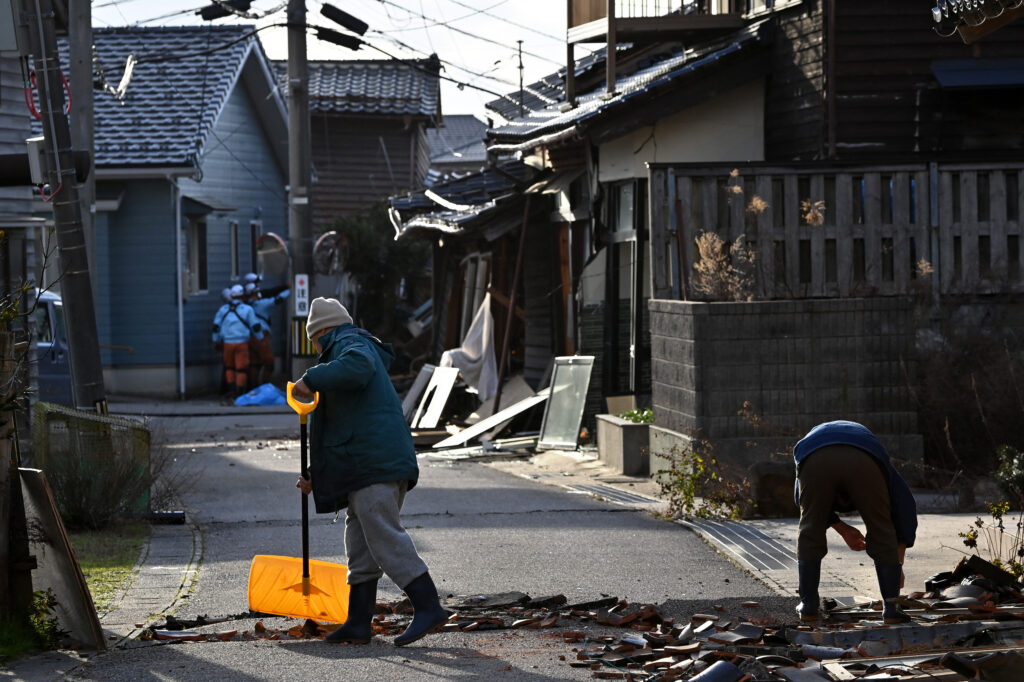
- ARAB NEWS
- 05 May 2024

Wajima, Ishikawa Pref: A huge earthquake that struck central Japan on Monday left deep scars especially on Ishikawa Prefecture, including its Noto region.
The city of Wajima is one of the areas heavily damaged by the quake, which registered up to 7, the highest level on Japan’s seismic intensity scale.
In areas around the “Asaichi Dori” morning market street, a famous tourist attraction, white smoke was rising from many buildings that were burned by fires caused by the earthquake.
A building fell on its side, crushing a neighboring structure. A large crack appeared on the playground at a junior high school in the city.
At a fishing port in the city of Suzu, located at the tip of the Noto Peninsula, some fishing boats capsized while others hit houses after running onto the quay. Also in the city, some utility poles tilted, and houses collapsed.
A large amount of debris was scattered around a fishing port in the town of Noto. A single-story house was submerged in the sea after apparently being washed away by tsunami.
In the city of Nanao, a large part of the slope of the Noto Satoyama Kaido expressway collapsed.
Local residents affected by the earthquake spoke about their experiences and fears.
“The sky was red, and it smelled like something was burning,” Shoji Yamashita, 59, who runs a restaurant in Wajima, said of the fires that occurred in the central area of the city. Outside the restaurant, a traffic light at an intersection fell down, and roads were caved in or raised here and there, according to Yamashita.
Damage from the earthquake is worse than in quakes that hit the region in the past, Yamashita said. “I’m worried about everything.”
“When I was walking in search of water, I found a seven-story building collapsed,” said a 55-year-old male resident of the city.
“My house was destroyed by the quake, and I’m struggling for food because electricity and water supplies have stopped, and convenience stores are not open,” a 77-year-old woman in the city said.
In the town of Shika, where the New Year’s Day quake measured the highest level of 7 on the Japanese seismic intensity scale, many people evacuated to facilities offered as shelters.
Kazuhiko Tada, a 58-year-old corporate worker in Kanazawa, the capital of Ishikawa, who evacuated to a Shika elementary school, said that the quake occurred while he was back in Shika, his hometown, during the year-end and New Year holidays.
“Windows and dishes (at my house) were broken, and the inside of the house was scattered with broken pieces of glass,” he said, adding that there were many aftershocks on Monday night.
A 32-year-old evacuee complained of shortages of diapers for her baby and meals.
In Suzu, 69-year-old taxi driver Kikuo Hamatsuka was driving his taxi with a customer when the quake struck.
After his taxi became unable to move due to damage to the road caused by the temblor, he left the vehicle and evacuated his customer to higher ground to escape a possible tsunami. He then found his taxi washed away by tsunami.
“I don’t know what would have happened if we had evacuated a little later,” Hamatsuka said, recalling the horror of tsunami.
In Nanao, some 650 people evacuated to a local elementary school located near the city government building soon after the quake occurred.
But an official said, “Blankets are in short supply, and we can’t use heaters because of a lack of kerosene.”
Noto General Hospital in Nanao was flooded as a sprinkler system was activated late at night.
The hospital has also been hit by a water shortage due to damage to the water tank, and treatment of patients needing dialysis therefore has been affected.
“I couldn’t sleep because aftershocks continued,” a nurse at the hospital said.
JIJI Press